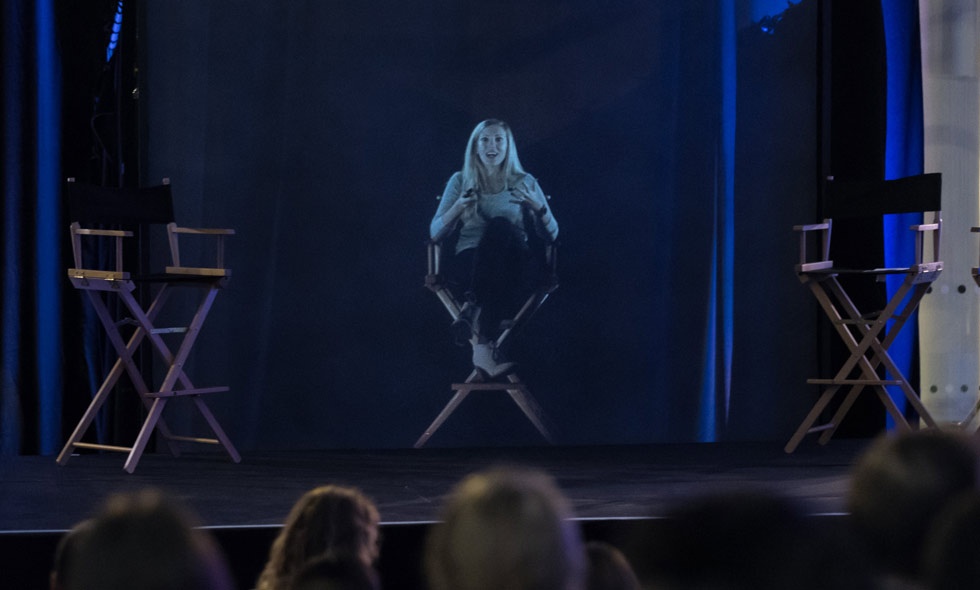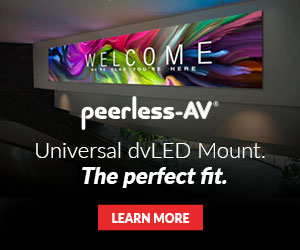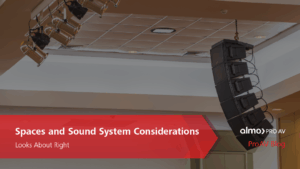This is part two of a three-part blog series on ARHT Media’s new Holographic TelePresence technology, distributed in the U.S. exclusively through Almo Professional A/V. You can find part one here.
Providers like Zoom have done an amazing job supporting the new remote world this year. But if you’re now video conferencing all day, you may be “Zoomed out” from all the video calls. I know I am.
What seems like endless video conferences, webinars, and virtual meetings has been, well, fine. And necessary during this cultural shift in work and meetings. But we can only thrive so long on standard 2D video conferencing.
In remote and virtual settings, 2D video conferencing only scratches the surface of what is possible.
In part one of this three-part blog series, we gave you the scoop on something new and exciting that could change video meetings and virtual events. That something is called Holographic TelePresence, and it’s a solution from ARHT Media that brings lifelike, interactive holographic display content to your event, room or computer screen. Holographic TelePresences creates a unique and highly engaging experience like no other.
To add to the excitement, ARHT’s new Virtual Global Stage (VGS)platform is a premium, digital experience. It offers the look and feel of a professional broadcast but streamed online. Through the Virtual Global Stage, presenters, panelists and lecturers around the world can participate from wherever they can access a capture studio.
Imagine the possibilities when you eliminate the need for a huge venue, expensive travel, and the physical gathering of attendees.

Unlike AR and VR, No Headset Is Needed With Holographic TelePresence
Do you know how hologram technology works? Below, we explain how ARHT Media does it.
Using proprietary technology, capture studios, and standard projection equipment, Holographic TelePresence “beams” presenters into one or multiple venues simultaneously. You may also hear the technology referred to as HoloPresence, short for “holographic presence.” Presenters can be located anywhere in the world — they just need the equipment and access to the platform via the web. Along with a new hologram presentation platform known as the Virtual Global Stage, Holographic TelePresence enables hybrid events — with some participants attending remotely and some attending live.
In other words, ARHT’s hologram events can run with all-remote participants/presenters, or with some live and some remote participants/presenters. Attendees and speakers choose how they participate — remotely or face to face — which empowers choice and flexibility. The value is that events can reach their largest possible audience. Organizations can also deliver a premium experience that goes well beyond the 2D video call.
To explain how Holographic TelePresence works, we’ll distinguish it from holograms, virtual reality (VR) and augmented reality (AR).
- Holographic TelePresence vs. Holograms: There is a distinction to be made between true holograms — 3D images produced in mid-air — and Holographic TelePresence. The “ARHT” (pronounced “art”) in ARHT Media stands for Augmented Reality Holographic Technology. It turns out that ARHT’s solution is not exactly equatable to a hologram, even though the final result appears as one. (Quick note: we will refer to the imagery produced by ARHT’s technology as “holograms;” just know we’re using that term as a general understanding of the final result — lifelike images that appear to the audience as holograms. We’re doing that for simplicity’s sake, not specifically to annoy the technology purists out there.)
- Holographic TelePresence vs. AR and VR: How does ARHT’s solution differ from other new hologram technology, virtual reality and augmented reality? VR blocks out your ability to see and hear the real world — usually through a VR headset. AR uses a computer and, sometimes, a special headset or glasses to create digital objects and overlay them onto what you see in our physical world. Are you familiar with Pokémon GO? That’s also augmented reality.
Holographic TelePresence is a projection that uses an illusion effect powered by ARHT’s “HumaGram” technology. ARHT’s technique is more sophisticated than others you may know, like Pepper’s Ghost. Contrasting AR and VR to Holographic TelePresence, ARHT’s solution is neither augmented reality nor virtual reality alone. Holographic AR is steps beyond — no headset or special glasses needed.
With these distinctions and a new understanding, we’re ready to reveal the minimal equipment it takes to deploy ARHT’s hologram technology in any space.
Debunking the Technology
To virtually stage a room, Holographic TelePresence requires a more precise setup than video conferencing or a remote presentation system, but the concept and necessary equipment are pretty straightforward. ARHT’s setup is a combination of video shot in front of a backdrop, then projected on stage (or “on stage,” if being done virtually) onto a screen. So, the production needs a screen, as well as controlled lighting, to ensure the projection is bright and visible.
In an article with Inavate Magazine, Andrew Parry, an online learning video producer at Imperial College Business School, explained further. Elements to consider include the capture space (plus, distance between camera and subject), the height/positioning of the camera, and lighting. In the case of Imperial College’s virtual stage design, Parry explained, lights placed behind the subject backlit everything, including shoes. He added that there were also two lights arranged in front of the subject to improve the lighting of the human hologram on the other end.

Factors such as lighting and camera angle ensure that the final result — holographic display images on the screen — is an accurate representation in terms of body shape and dimensions. Thankfully, the AV industry is quite familiar with the principles of projection, making the execution of this technology, once learned, quite straightforward.
Below, you’ll see some behind-the-scenes photos of the setup in a recent hologram teleconference held live with ARHT’s hologram tech. In the interview, rAVe [PUBS] founder Gary Kayye (beaming in from North Carolina) and Almo’s Sam Taylor (beaming in from Maryland) are using ARHT’s Virtual Global Stage. To the audience, the two appeared virtually on the same “stage” with no editing, and no latency lag, having a real-time conversation about the emerging interactive hologram technology.

Will Hologram Technology Change Business in 2020?
While holograms have gotten plenty of attention in the media these past few years, many could be asking if this is just a trend. Will on-stage holograms like ARHT Media’s become big business? What can we expect from hologram technology in the future?
We believe any industry — higher education, live events, advertising and entertainment, healthcare, corporate spaces, meeting spaces, you name it — will benefit from 3D holographic display technology.
Get in touch with Almo today for more information, and visit www.almoproav.com/holographic-telepresence to find your regional service development manager.









